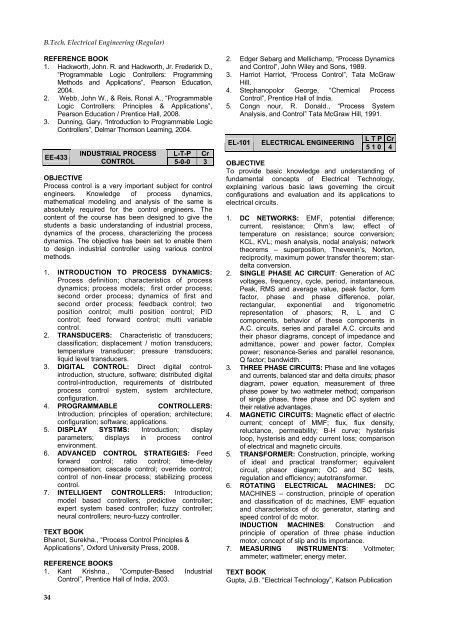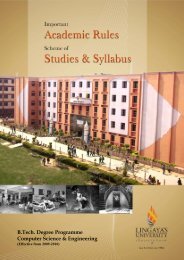B.<strong>Tech</strong>. <strong>Electrical</strong> <strong>Engineering</strong> (Regular)REFERENCE BOOK1. Hackworth, John. R. and Hackworth, Jr. Frederick D.,“Programmable Logic Controllers: ProgrammingMethods and Applications”, Pearson Education,2004.2. Webb, John W., & Reis, Ronal A., “ProgrammableLogic Controllers: Principles & Applications”,Pearson Education / Prentice Hall, 2008.3. Dunning, Gary, “Introduction to Programmable LogicControllers”, Delmar Thomson Learning, 2004.EE-433INDUSTRIAL PROCESS L-T-P CrCONTROL 5-0-0 3OBJECTIVEProcess control is a very important subject for controlengineers. Knowledge of process dynamics,mathematical modeling and analysis of the same isabsolutely required for the control engineers. Thecontent of the course has been designed to give thestudents a basic understanding of industrial process,dynamics of the process, characterizing the processdynamics. The objective has been set to enable themto design industrial controller using various controlmethods.1. INTRODUCTION TO PROCESS DYNAMICS:Process definition; characteristics of processdynamics; process models; first order process;second order process; dynamics of first andsecond order process; feedback control; twoposition control; multi position control; PIDcontrol; feed forward control; multi variablecontrol.2. TRANSDUCERS: Characteristic of transducers;classification; displacement / motion transducers;temperature transducer; pressure transducers;liquid level transducers.3. DIGITAL CONTROL: Direct digital controlintroduction,structure, software; distributed digitalcontrol-introduction, requirements of distributedprocess control system, system architecture,configuration.4. PROGRAMMABLE CONTROLLERS:Introduction; principles of operation; architecture;configuration; software; applications.5. DISPLAY SYSTMS: Introduction; displayparameters; displays in process controlenvironment.6. ADVANCED CONTROL STRATEGIES: Feedforward control; ratio control; time-delaycompensation; cascade control; override control;control of non-linear process; stabilizing processcontrol.7. INTELLIGENT CONTROLLERS: Introduction;model based controllers; predictive controller;expert system based controller; fuzzy controller;neural controllers; neuro-fuzzy controller.TEXT BOOKBhanot, Surekha., “Process Control Principles &Applications”, Oxford University Press, 2008.REFERENCE BOOKS1. Kant Krishna., “Computer-Based IndustrialControl”, Prentice Hall of India, 2003.2. Edger Sebarg and Mellichamp, “Process Dynamicsand Control”, John Wiley and Sons, 1989.3. Harriot Harriot, “Process Control”, Tata McGrawHill.4. Stephanopolor George, “Chemical ProcessControl”, Prentice Hall of India.5. Congn nour, R. Donald., “Process SystemAnalysis, and Control” Tata McGraw Hill, 1991.EL-101ELECTRICAL ENGINEERINGL T P Cr5 1 0 4OBJECTIVETo provide basic knowledge and understanding offundamental concepts of <strong>Electrical</strong> <strong>Tech</strong>nology,explaining various basic laws governing the circuitconfigurations and evaluation and its applications toelectrical circuits.1. DC NETWORKS: EMF, potential difference;current, resistance; Ohm’s law; effect oftemperature on resistance; source conversion;KCL, KVL; mesh analysis, nodal analysis; networktheorems – superposition, Thevenin’s, Norton,reciprocity, maximum power transfer theorem; stardeltaconversion.2. SINGLE PHASE AC CIRCUIT: Generation of ACvoltages, frequency, cycle, period, instantaneous,Peak, RMS and average value, peak factor, formfactor, phase and phase difference, polar,rectangular, exponential and trigonometricrepresentation of phasors; R, L and Ccomponents, behavior of these components inA.C. circuits, series and parallel A.C. circuits andtheir phasor diagrams, concept of impedance andadmittance, power and power factor, Complexpower; resonance-Series and parallel resonance,Q factor; bandwidth.3. THREE PHASE CIRCUITS: Phase and line voltagesand currents, balanced star and delta circuits; phasordiagram, power equation, measurement of threephase power by two wattmeter method; comparisonof single phase, three phase and DC system andtheir relative advantages.4. MAGNETIC CIRCUITS: Magnetic effect of electriccurrent; concept of MMF; flux, flux density,reluctance, permeability; B-H curve; hysterisisloop, hysterisis and eddy current loss; comparisonof electrical and magnetic circuits.5. TRANSFORMER: Construction, principle, workingof ideal and practical transformer; equivalentcircuit, phasor diagram; OC and SC tests,regulation and efficiency; autotransformer.6. ROTATING ELECTRICAL MACHINES: DCMACHINES – construction, principle of operationand classification of dc machines, EMF equationand characteristics of dc generator, starting andspeed control of dc motor.INDUCTION MACHINES: Construction andprinciple of operation of three phase inductionmotor, concept of slip and its importance.7. MEASURING INSTRUMENTS: Voltmeter;ammeter; wattmeter; energy meter.TEXT BOOKGupta, J.B. “<strong>Electrical</strong> <strong>Tech</strong>nology”, Katson Publication34
Lingaya’s University, FaridabadREFERENCE BOOKS1. Theraja, B.L. “<strong>Electrical</strong> <strong>Tech</strong>nology Vol I & II”, S.Chand Publications, 20052. Kothari and Nagarath, “Basic <strong>Electrical</strong> Engg.”, 2ndEdition, Tata McGraw Hill3. Theodore, Wildi “<strong>Electrical</strong> Machines, Drives andPower Systems”, 2nd Edition, Prentice Hall, 1991.4. Edward, Hughes (revised by Ian McKenzie Smith),“<strong>Electrical</strong> <strong>Tech</strong>nology”, 7th Edition, EnglishLanguage Book Society, Publication withLongman, 1995.5. Del Torro Vincent, “<strong>Electrical</strong> <strong>Engineering</strong>Fundamentals”, 2nd Edition, Prentice Hall of India,1994.6. Cathey, J.J. and Naser, S.A. “Basic <strong>Electrical</strong> Engg.”,2nd Edition, Schaum Series, McGraw Hill Publ.EL-151ELECTRICAL ENGINEERING L T P CrLAB 0 0 2 1LIST OF EXPERIMENTS1. To verify KCL and KVL.2. To verify Thevenin’s and Norton’s Theorems.3. To verify maximum power transfer theorem in D.CCircuit and A.C Circuit.4. To verify Reciprocity and Superposition theorems.5. To study frequency response of a series R-L-Ccircuit and determine resonant frequency and Q-Factor for various Values of R, L, C.6. To study frequency response of a parallel R-L-Ccircuit and determine resonant frequency and Q-Factor for various values of R, L, C.7. To perform direct load test of a transformer andplot efficiency Vs load characteristic.8. To perform open circuit and short circuit tests on asingle-phase transformer determine the losses andefficiency.9. To perform direct load test of a DC shunt generatorand plot load voltage Vs load current curve.10. To study various types of meters.11. Measurement of power by 3 voltmeter / 3 ammetermethod.12. Measurement of power in a 3 phase system by twowatt meter method.13. Connection and testing of a single-phase energymeter (unit power factor load only).REFERENCE BOOKS1. Theraja, B.L. “<strong>Electrical</strong> <strong>Tech</strong>nology Vol I & II”, S.Chand Publications, 20052. Kothari and Nagarath, “Basic <strong>Electrical</strong> Engg.”, 2ndEdition, Tata McGraw Hill3. Del Torro Vincent, “<strong>Electrical</strong> <strong>Engineering</strong>Fundamentals”, 2nd Edition, Prentice Hall of India,1994.4. Cathey, J.J. and Naser, S.A. “Basic <strong>Electrical</strong> Engg.”,2nd Edition, Schaum Series, McGraw Hill Publ.ELECTRICAL & ELECTRONICSL-T-P CrEL-201 MEASUREMENTS & MEASURINGINSTRUMENTS 5-0-0 3OBJECTIVEProviding sound knowledge about the need ofmeasurement of various electrical quantities and thevarious means and instruments required to accuratelymeasure them, also to explain the constructionalfeatures and principles of operation of various electricaland electronics instruments.PRE-REQUISITEBasic concepts and knowledge of Electronics and<strong>Electrical</strong> <strong>Engineering</strong>.1. MEASURING SYSTEM FUNDAMENTALS:Classification of Instruments (Absolute andSecondary; Indicating, Recording andIntegrating Instruments, Based Upon principle ofoperation); Block diagram and description ofblock of generalized instrument; 3 forces inelectromechanical Indicating Instrument(Deflecting, Controlling and Damping forces);Comparison between gravity and springcontrols; comparison of damping methods andtheir suitability; Bearing supports, Pivot-lesssupport, scale information, Instrument cases(covers).2. MEASURING INSTRUMENTS: Construction,operating principle, torque equation, shape ofscale, use as ammeter or as voltmeter (Extensionof ranges), Use on AC / DC or both; Advantagesand disadvantages, errors (Both on AC / DC) ofPMMC types; Electrodynamics type; Moving IronType (Attraction, Repulsion and Combined type);Hot wire type and Induction type; Electrostatictype instruments; Electrodynamics and Inductiontype wattmeters; Single phase induction typeenergy meters; compensation and creep in energymeters.3. POWER FACTORS & FREQUENCY METERS:Construction, operation principle torque equation,advantages and disadvantages of single phasepower factor meter (Electro dynamic and movingfrom types); <strong>Electrical</strong> resonances type, Ferrodynamic and electro dynamic type frequencymeter.4. A.C. BRIDGES: Classification of resistances,resistance – Measurements by Wheat StoneBridge ,Kelvin’s double bridge method and theirlimitation General Balance Equation, CircuitDiagram, Phasor Diagram, Advantage andDisadvantages, Application of Maxwell’sInductance, Inductance – Capacitance, Hay’s,Anderson’s, Owen’s, De-Sauty’s, Schering andWein’s Bridges, Shielding and Earthing.5. GENERATION AND ANALYSIS OFWAVEFORMS: Block Diagram of pulse-generator;Signal generators; Function Generators; Waveanalyzer; Distortion Analyzers; Spectrum analyzer;Harmonic Analyzer; Power Analyzer.6. ELECTRONIC MEASUREMENT: ElectronicVoltmeter; Multimeter; Wattmeter; Energy meter;Time; Frequency and phase measurements usingCRO; Spectrum and wave Analyzer; DigitalCounter; Frequency meter; storage oscilloscope.7. INSTRUMENTATION: Transducers; classificationand selection of transducers; strain Gauges;Inductive and Capacitive transducer; Piezo-electricand Hall-Effect transducers; Thermistors andhermo couples; Photo-Diode and Phototransistors;Encoder type digital transducer; Signalconditioning, Telemetry and Data Acquisitionsystem.35
- Page 1 and 2: B.Tech. Degree ProgrammeElectrical
- Page 5 and 6: Lingaya’s University, FaridabadAB
- Page 7 and 8: IMPORTANT ACADEMIC RULESB.Tech. Deg
- Page 9 and 10: Lingaya’s University, Faridabadac
- Page 11 and 12: Lingaya’s University, FaridabadSe
- Page 13 and 14: Lingaya’s University, FaridabadIn
- Page 15 and 16: CATEGORY-WISE LIST OF COURSESLingay
- Page 17 and 18: Lingaya’s University, FaridabadSU
- Page 19 and 20: Lingaya’s University, FaridabadSc
- Page 22 and 23: B.Tech. Electrical Engineering (Reg
- Page 24 and 25: B.Tech. Electrical Engineering (Reg
- Page 26 and 27: B.Tech. Electrical Engineering (Reg
- Page 28 and 29: B.Tech. Electrical Engineering (Reg
- Page 30 and 31: B.Tech. Electrical Engineering (Reg
- Page 32 and 33: B.Tech. Electrical Engineering (Reg
- Page 34 and 35: B.Tech. Electrical Engineering (Reg
- Page 36 and 37: B.Tech. Electrical Engineering (Reg
- Page 40 and 41: B.Tech. Electrical Engineering (Reg
- Page 42 and 43: B.Tech. Electrical Engineering (Reg
- Page 44 and 45: B.Tech. Electrical Engineering (Reg
- Page 46 and 47: B.Tech. Electrical Engineering (Reg
- Page 48 and 49: B.Tech. Electrical Engineering (Reg
- Page 50 and 51: B.Tech. Electrical Engineering (Reg
- Page 52 and 53: B.Tech. Electrical Engineering (Reg
- Page 54 and 55: B.Tech. Electrical Engineering (Reg
- Page 56 and 57: B.Tech. Electrical Engineering (Reg
- Page 58 and 59: B.Tech. Electrical Engineering (Reg
- Page 60 and 61: B.Tech. Electrical Engineering (Reg
- Page 62 and 63: B.Tech. Electrical Engineering (Reg
- Page 64 and 65: B.Tech. Electrical Engineering (Reg
- Page 66 and 67: B.Tech. Electrical Engineering (Reg
- Page 68 and 69: B.Tech. Electrical Engineering (Reg
- Page 71 and 72: OPEN ELECTIVELingaya’s University
- Page 73 and 74: Lingaya’s University, Faridabadch
- Page 75 and 76: Lingaya’s University, Faridabad4
- Page 77 and 78: Lingaya’s University, Faridabad6.
- Page 79 and 80: Lingaya’s University, FaridabadEL
- Page 81 and 82: Lingaya’s University, Faridabad5
- Page 83 and 84: Lingaya’s University, Faridabador
- Page 85 and 86: Lingaya’s University, Faridabad4.
- Page 87: Lingaya’s University, Faridabad83
















